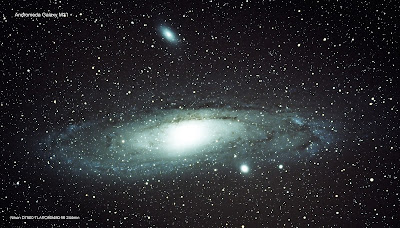The picture is a combination of two pictures, both with Nikon D7500 and TAL200K f/8.5:
Pascal Hilkens Astro Home Page
Saturday, October 31, 2020
Halloween Sunspots
The picture is a combination of two pictures, both with Nikon D7500 and TAL200K f/8.5:
Tuesday, October 27, 2020
Supernova SN2020rcq
UGC 6930 (Uppsala General Catalogue of Galaxies) is part of the M109 group and located in constellation Ursa Major and about 50million ly away from Earth. The galaxy shows an "extra" star which is a supernova (SN2020rcq). The picture was taken with COAST C14 f/11 telescope on Tenerife. Exposure time 120 and no filters. I embedded a picture of UGC6930 from Simbad to compare with the Coast picture.
Saturday, October 24, 2020
The Making of my Andromeda M31 astropicture
New Bright Comet Atlas C/2020 M3
It's currently visible in constellation Lepus and moving toward Orion. For more information see The SkyLive.
VVS Deepsky Dag November 7, 2020 - online via Youtube
Thursday, October 22, 2020
Monday, October 19, 2020
Twin Paradox Minkowski Diagram
Left : earth twin "leaving" the rocket twin
Right : earth twin "staying, and the rocket heading away (and returning)
Both believe the other one is younger as they "see" the other one moving away.
Saturday, October 17, 2020
Thursday, October 15, 2020
Mars to Opposition
Wednesday, October 14, 2020
Opposition Mars
Setting : ZWO224MC and TAL200K f/8.5 with ADC and Barlow x2. 127 frames per second. Stacking with AutoStakkert! and final editing using CS4.
Tuesday, October 13, 2020
Calsky C'est fini
Friday, October 9, 2020
Andromeda Galaxy M31 - Total exposure 244minutes
This picture of the Andromeda Galaxy M31 is the result of a total of 317 individual pictures made in 5 different night sessions:
- 62 x 60s ISO2500
Monday, October 5, 2020
Saturday, October 3, 2020
Tumbling object near NGC7008
Planetary Nebula NGC6894
Planetary Nebula NGC 6894 is located in constellation Cygnus and about 5443ly away from Earth. It was not my intention to observe this nebula as I was searching for another planetary nebula. I must have used a different number... by luck it was also a planetary nebula. On the picture is also a double star NGC6896 and open star cluster IC1315.
Setting : Nikon D7500 and TLAPO80/480 f/6, ISO3200, lights 16x60s, darks 5x60s. Camera was controlled via software DigiCamControl. Stacking of nef files using APP and final editing and cropping with CS4.
Planetary Nebula NGC7008 or Fetus Nebula
NGC 7008 (Fetus Nebula) is a planetary Nebula located in constellation Cygnus and about 2800ly away from Earth. In the middle of the nebula we can observe the central star (mag 13). According database Simbad two stars, very close to each other and each mag 13 are in the middle of the nebula. It is not clear to me of both or only one is part of NGC 7008.
Setting : Nikon D7500 and TLAPO 80/480 f/6; ISO3200, lights 16x60, darks 5x60. Stacking of raw (nef) data using APP and final editing and cropping with CS4 (tiff to Jpg).
Bow-Tie (Vlinderdas) Nebula NGC40
Thursday, October 1, 2020
Solar Storms : Astronomy Online from American National Museum of History
My pictures published in magazine Heelal
I'm proud that two of my pictures : the noctilucent clouds storm of July 5 and Comet Neowise C/2020 F3 are both published in magazine Heelal (Heelal edition september 2020 and Heelal edition oktober 2020)
Gold Messier Certificate
Today I received my Gold Messier Certificate. The certificate was provided by the VVS (Janos Barabas) as a result of completing the observation of all 110 Messier objects.

























